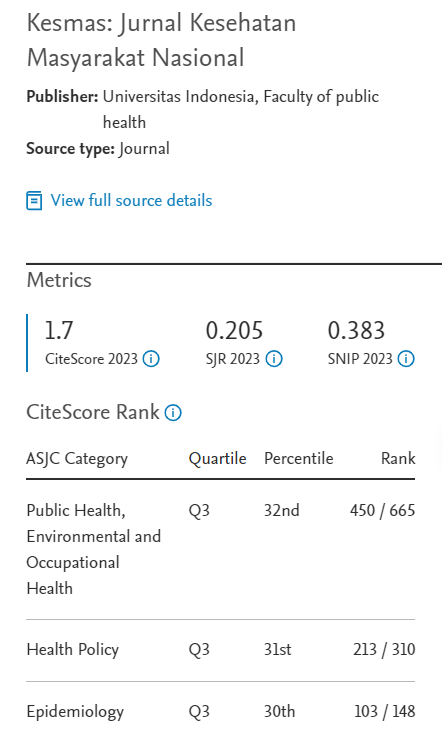Abstract
Healthcare facilities generate medical waste. If not properly managed, medical waste may damage the environment and spread diseases. Many hospitals in Indonesia do not adhere to medical waste management regulations. This study aimed to evaluate the management of solid medical waste at four public hospitals in Bogor District, Indonesia. A case study design was used to obtain a comprehensive description of the solid medical waste management activities inthe hospitals. Data were collected through direct observations, interviews, and document reviews. This study revealed that the medical waste generated in allhospitals was infectious, pathological, pharmaceutical, chemical, and cytotoxic, totaling approximately 4,000-12,000 kg. Hospitals A, B, C, and D fulfilled the Regulation of the Indonesian Ministry of Environment and Forestry No. P56 of 2015 criteria, achieving compliance rates of 77%, 83.78%, 83.3%, and 86.48%, respectively. However, several activities of the hospitals did not meet the standards for waste reduction, segregation, on-site transport, temporary storage, and human resource quality. It is important that hospitals establish comprehensive and compliant medical waste management systems.
References
1. United States Environmental Protection Agency. Criteria for the Definition of Solid Waste and Solid and Hazardous Waste Exclusions. Washington, DC: United States Environmental Protection Agency; 2023.
2. Direktorat Kesehatan Lingkungan. Laporan Kinerja Kegiatan Kesehatan Lingkungan Tahun 2021. Jakarta: Kementerian Kesehatan Republik Indonesia; 2022.
3. Global Green and Healthy Hospital. Waste. Reston, VA: Global Green and Healthy Hospital; 2023.
4. World Health Organization. Health-care Waste. Geneva: World Health Organization; 2018.
5. Meleko A, Tesfaye T, Henok A. Assessment of Healthcare Waste Generation Rate and Its Management System in Health Centers of Bench Maji Zone. Ethiop J Health Sci. 2018; 28 (2): 125–134. DOI: 10.4314/ejhs.v28i2.4
6. Kenny C, Priyadarshini A. Review of Current Healthcare Waste Management Methods and Their Effect on Global Health. Healthcare. 2021; 9 (3): 284. DOI: 10.3390/healthcare9030284
7. Pépin J, Abou Chakra CN, Pépin E, et al. Evolution of the global burden of viral infections from unsafe medical injections, 2000-2010. PLoSOne. 2014; 9 (6): e99677. DOI: 10.1371/journal.pone.0099677
8. Firmansyah F. Pengolahan Limbah Medis Fasyankes Menjadi Perhatian Khusus. Jakarta: Kementerian Kesehatan Republik Indonesia; 2019.
9. Univesitas Gadjah Mada. Pengelolaan Limbah Medis di Indonesia Belum Maksimal. Yogyakarta: Univesitas Gadjah Mada; 2019.
10. Mutiara P, Suryatna K. Soroti Penanganan Limbah Medis yang Meningkat Selama COVID-19. Jakarta: Kementerian Koordinator Bidang Pembangunan Manusia dan Kebudayaan Republik Indonesia; 2021.
11. Kementerian Komunikasi dan Informasi Republik Indonesia. Presiden Minta Jajarannya Intensifkan Pengelolaan Limbah Medis COVID-19 secara Sistematis. Jakarta: Kementerian Komunikasi dan Informasi Republik Indonesia; 2021.
12. Kementerian Kesehatan Republik Indonesia. Capaian Indikator - Kesehatan Lingkungan 2022. Jakarta: Kementerian Kesehatan Republik Indonesia; 2022.
13. Menteri Linkungan Hidup dan Kehutanan Republik Indonesia. Peraturan Menteri Lingkungan Hidup dan Kehutanan Republik Indonesia Nomor P56 Tahun 2015. Tata Cara dan Persyaratan Teknis Pengelolahan Limbah Bahan Berbahaya dan Beracun dari Fasilitas Pelayanan Kesehatan. Jakarta: Kementerian Linkungan Hidup dan Kehutanan Republik Indonesia; 2016.
14. Chartier Y, Emmanuel J, Pieper U, et al (eds.). Safe management of wastes from health-care activities, 2nd ed. Geneva: World Health Organization; 2014. 329 p.
15. Basel Convention. Healthcare or Medical Waste. Nairobi: United Nations Environment Programme; 2017.
16. Healthcare Environmental Resource Center. Purchasing/Receiving/ Inventory. United States of America: Healthcare Environmental Resource Center; 2015.
17. United Nations Development Programme. Module 10: Segregation of Healthcare Waste Module Overview. Geneva: World Health Organization; 2020.
18. Kementerian Kesehatan Republik Indonesia. Pedoman Pengelolaan Limbah Rumah Sakit Rujukan, Rumah Sakit Darurat dan Puskesmas yang Menangani Pasien COVID-19. Jakarta: Kementerian Kesehatan Republik Indonesia; 2020.
19. Menteri Kesehatan Republik Indonesia. Peraturan Menteri Kesehatan Republik Indonesia Nomor 7 Tahun 2019 Tentang Kesehatan Lingkungan Rumah Sakit. Jakarta: Kementerian Kesehatan Republik Indonesia; 2019.
20. United Nations Development Programme. Module 13: On-site Transport and Storage of Healthcare Waste. Geneva: World Health Organization; 2020.
21. Pemerintah Republik Indonesia. Peraturan Pemerintah Nomor 22 Tahun 2021 Tentang Pedoman Perlindungan dan Pengelolaan Lingkungan Hidup. Jakarta: Kementerian Dalam Negeri Republik Indonesia; 2021.
22. Menteri Lingkungan Hidup dan Kehutanan Republik Indonesia. Peraturan Menteri Lingkungan Hidup dan Kehutanan Republik Indonesia Nomor 6 Tahun 2021. Jakarta: Kementerian Lingkungan Hidup dan Kehutanan Republik Indonesia; 2021.
23. International Committee of the Red Cross. Medical Waste Management. Geneva: International Committee of the Red Cross; 2020.
24. Ministry of Health and Population Nepal. Health Care Waste Management Guideline 2014. Kathmandu: Public Health Update; 2019.
25. United States Environmental Protection Agency. Community Guide to Incinerator. Washington, DC: United States Environmental Protection Agency; 2021.
26. National Health Service England. Environment and Sustainability Health Technical Memorandum 07-01: Safe management of healthcare waste. London: National Health Service England; 2022.
27. Biosafety Program. Biohazardous Waste Categories. Knoxville: The University of Tennessee.
28. The Global Fund. Technical Brief: Avoidance, Reduction and Safe Management of Health Care Waste, Allocation Period 2023-2025. Geneva: The Global Fund; 2022.
29. Adhani R. Pengelolaan Limbah Medis Pelayanan Kesehatan. Banjarmasin: Lambung Mangkurat University Press; 2018.
30. United Nations Development Programme. Module 24: Institutionalization of HCWM – Organization, Training, Financing and Quality Improvement. Geneva: World Health Organization; 2020.
31. United Nations Development Programme. Monitoring Barriers and Gaps to Sustainable Healthcare Waste Management in Ukrainian Healthcare Facilites. New York City: United Nations Development Programme; 2023.
32. Kementerian Lingkungan Hidup dan Kehutanan Republik Indonesia. Rincian Teknis Penyimpanan Limbah B3. Jakarta: Kementerian Lingkungan Hidup dan Kehutanan Republik Indonesia; 2021.
Recommended Citation
Khansa S , Kusumayati A , Susanna D ,
et al.
Evaluation of Solid Medical Waste Management in Bogor Regional Public Hospitals.
Kesmas.
2023;
18(4):
217-225
DOI: 10.21109/kesmas.v18i4.7318
Available at:
https://scholarhub.ui.ac.id/kesmas/vol18/iss4/2







